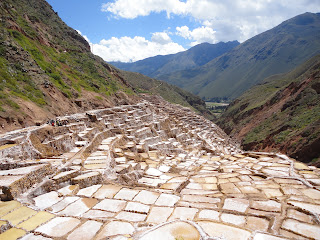Moving on from Cusco towards the Sacred Valley of the Incas where the Inca Trail begins we travelled through Chinchero, Moray and Maras on our way to our overnight stop at Ollantytambo, the last town in the valley before Machu Picchu and where you get the train if you want to visit it the easy way.
|
At the Inca terraces at Moray |
Today has been a fascinating insight into traditional life in rural Peru whose level of wealth does not seem far removed from the equivalent village in Cameroon. Villagers walk their animals along the narrow roads and grow potatoes on the steep Inca terraces built into the side of 5000m high snow covered mountains.
|
Dyeing alpaca wool using cochineal |
We saw traditional weaving and dyeing of alpaca wool using natural ingredients such as the cochineal beetle and visited a salt mine where whole families continue to scrape a living. Our guide said she had met a woman of over 80 who had been extracting salt from the ponds on the hillside for well over half a century. The families need the children to work there too and large families persist because more workers are needed.
Others have of course switched focus to the tourist market and who can blame them, as traditional life looks tough and increasingly economically unviable. They find their way to the city and an uncertain future where some women make a living by posing for photos in traditional dress with llamas of all ages. The baby lambs are sweet and make the best returns. The street sellers are persistent and start young too. We've met the same 7 year old a couple of times in the town square in Cusco. Being 7 years old his sales technique is abrupt but endearing. "Buy my doll" he instructs you in English, followed by "I take credit card"! When you say no, like any child he demands "why?".
So the choice is the between the harsh reality of traditional rural family life and the potentially harsher reality of a city which at least offers a small chance of making your fortune.



No comments:
Post a Comment